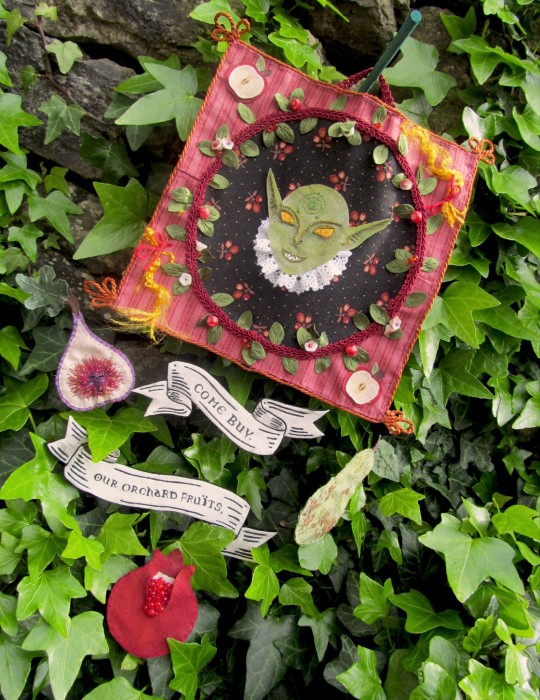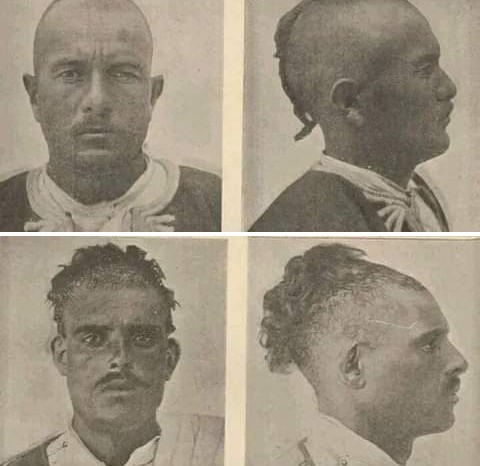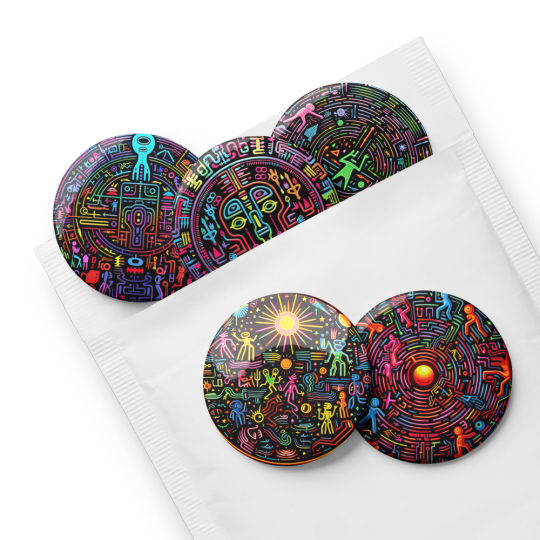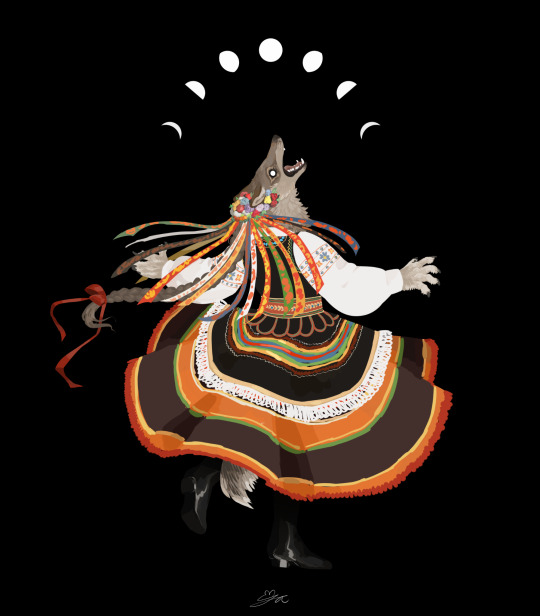#folkloric
Text






look for the name: ELENA-MARIJA
dolce & gabbana strapless deconstructed gingham gown w/ blue crinoline and lace trim, s/s 2oo6
{hair} raffia and pearl spike-studded hair accessroies + straw-wrapped braided tresses @ simone rocha s/s 2o2o
dolce & gabbana romantic porcelain cameo choker, c. 1992
columbian straw heart-shaped purse
italian or french gilded and painted carved wood ladies shoes of pierced and carved gesso and lacquered wood w/ exaggerated pointed toes painted with tulips and dog roses, the upper with lace-effect piercings with faux latchets and eyelets for threading ribbons; c. second half 17th century
#elena-marija#name#request#outfit#hope you like !#folkloric#i'm obsessed with these shoes btw#footwear#wood#carved#17th cent.#bag#raffia#straw#columbian#dolce & gabbana#jewellry#necklace#porcelain#hair#simone rocha#2ooo's#199o's#gown#gingham#queue
65 notes
·
View notes
Photo

Podpoľanie Slovak Costumes - Jan Mikus
76 notes
·
View notes
Text
'The Oldest Game' - the myth and folklore of the battle between Morpheus and Lucifer in 'The Sandman' on Netflix (a folklorist chimes in)

Lucifer and Morpheus in a 'wizard's duel', 'The Sandman' episode 4 'A Hope in Hell'
The memorable, grandiose scene in which Dream and the Morning Star face-off in a battle of cosmic scale is no mere magic of visual effects – it is a shamanic, shape-shifting dance of transformation which has its roots in myth and folklore.
It is a continuous chase in which its participants take on different shapes with one goal in mind: to overpower one another. In this form the mythical chase found its expression in the so-called 'wizard's duel', which we find in various European fairy tales and now before our eyes - as the Morning Star once again takes on the skin of the Serpent, poisoning the hunter-donning Morpheus in a visually stunning cosmic play.
Where does the transformation chase come from?
The Carmina Gadelica, a compendium of folkloric texts gathered in Scotland by the folklorist Alexander Carmichael in the 19th century, mentions a magical spell, or rather an occult power by the name of 'fith-fath' which can make one transform into something else or render them invisible. It is said that these transformations might have even occurred involuntarily. The Carmina Gadelica accentuates the importance of these spells to hunters, travelers and warriors, so that they could stay invisible and unrecognizable to animals and possible enemies.
The Mabinogion, a compilation of the earliest Celtic tales (first published in 1840), tells the story of Ceridwen, an enchantress of Welsh myth who had made a 'Cauldron of Inspiration'. The reason for making this magical cauldron is to help her disfigured son Morfran (Morvran ab Tegid) gain knowledge of the mysteries and the things to come. In this way, Ceridwen thought she could give her son a chance to prove himself to the world. As the year-long process of brewing a magical brew in the cauldron had begun, she employed a youth by the name of Gwion Bach to keep watch of the brew and to stir it as needed. One day, three drops of the brew fell out of the cauldron and found themselves on Gwion's finger. Feeling drawn to the liquid's power, he licked them off and instantly absorbed the mystical knowledge of all there is to come. Therefore, he knew this one thing as well – he must run, run from the wrath of Ceridwen, as this power was not his to have.
The sorceress sees him and begins the chase. Gwion, now having the power of transformation, turned into a hare trying to evade her. Ceridwen is now a lithe greyhound and there is no way for the hare to escape. Gwion runs towards a river and turning into a fish, escapes into the quick waters. A hungry and angry otter is the next form of Ceridwen, as she is hunting the fish. Gwion, swimming for his life, dons the wings of a bird in order to fly out of the water. The sorceress keeps up and turns herself into a hawk, a deadly bird of prey, ready to finish the shamanic, deadly chase. However, Gwion manages to outsmart her by becoming a grain of wheat on the floor of a barn, blending into the surroundings and becoming unnoticable. That is when Ceridwen becomes a black hen and finding the grains, eats Gwion in the process.
It is this Gwion, now imbued with the magical powers of the Cauldron of Inspiration, who later gets 'born again' and becomes the mythical poet Taliesin.
One whose knowledge transgresses time and space, as this knowledge is beyond them both. Shapeshifting is a primordial memory, an ancient form of magic so deeply ingrained into our cultural muscle that it is continually expressing itself. Masked dances of old, ritual plays, the theatre and the movies – all a part of the same magical urge to transform, to move to another state of existence.
- Heidi (@theatrum-tenebrarum)

„I am a serpent. Horse-biting, poison-toothed.“ (Lucifer as a serpent in the transformation chase)

"I am a bird of prey. Snake-devouring, talons-ripping.“ (Morpheus as a bird of prey in the transformation chase, outsmarting Lucifer)

„I am a universe. All things encompassing, all life embracing.“ (Morpheus as a universe in the transformation chase)

„I am anti-life. The Beast of Judgement. The dark at the end of everything.“ (Lucifer, whose grand shadow looms in the background, is now anti-life, extinguishing the Life of a Universe)
Heidi (@theatrum-tenebrarum)
#thesandman#sandman#the sandman netflix#gwendoline christie#lucifer morningstar#lucifer#dream#morpheus#sandman netflix#hell#a hope in hell#folklore#folkloric#folklorist#neil gaiman#tom sturridge#myth#mythology#celtic mythology#mabinogi#ceridwen#tv#netflix series#analysis#cultural anthropology#shamanic#inspiration#anthropologist#shapeshifing#folkloreinpopularmedia
496 notes
·
View notes
Text

🍏🍓 Goblin Market🍊 come buy🫐come buy🍇🍐. Patchwork panel 16x16cm with hanging embroidery fruits.
#english folklore#folklore#fae folk#folk magic#folk art#folkloric#goblin market#goblincore#goblin aesthetic#goblin#cottagecore#fairy tales#english folk art#pre raphaelite#whimsigoth#whimiscal#aesthetic#my art#art#textile art#textile#textiles#embroidery#cryptid aesthetic#cryptidcore#dungeons and dragons#medieval core#fae core#faecore#faerie
15 notes
·
View notes
Text

all year round
#It started with Jennifer's Body makeup#romanisme#romania#Romanian blouse#lablouseroumaine#ie#maramă#Teleorman#romanian folklore#ielele#eastern europe#balkans#slavic folklore#folkloric#vampire
26 notes
·
View notes
Text

Old pictures of Tunisians back in the late 19th century showing the common haircut back then. The imazighen used to shave all of the head safe for the back. In Tunisian dialect, it's called “ shūsha ” or in tamazight “ tashusht ”. It was considered a symbol of masculinity since the ancient times.
#tunisia#north africa#africa#berber#amazigh#tunisian#photography#maghreb#traditional#history#19th century#antiquity#traditions#folklore#folkloric
358 notes
·
View notes
Photo

Happy fair to all and enjoy the spring✨
Andalusian art. Folkloric personal illustration
Personal practice, focused on the elements that surround the festivity of my city, The April Fair of Seville.
Inspired by its folkloric characteristics, we can see represented the clothing, decorations, vegetation, instruments and drinks.
#artpiece , #humanartist #Sevilla
#andalusian art#sevilla#feria#flamenca#rebujito#illustration#noAi#humanartist#folkloric#paint#cover#manton#guitarra
13 notes
·
View notes
Text

Darlings! Please check out our amazing interview with The Folklore Podcast! Psyched & honored to have done this deep-dive with interviewer Hilary Wilson on the reasons why A HAUNTED HISTORY OF INVISIBLE WOMEN broke new ground & remains a prompt to examine the ways we talk about women, alive and dead. We're thrilled this book continues to find new audiences! If this topic interests you, please give the podcast a listen and pick up our book, available wherever books are sold!
#ghosts#gothic#victorian#women's studies#women#womens issues#womens history#ghost stories#folklore#urban legends#women ghosts#female ghosts#women writers#nonfiction#tour guide#ghost tour#the folklore podcast#folkloric#podcast#interview#ghost book#spooky reads#spooky books
2 notes
·
View notes
Text


Cyber-Shamanic/Mythological Pin Set arrived to my Etsy store.
Embark on a journey into the ancient realm of Memetic mythology, collecting its historical artifacts as tokens of your valor.
⋊ ⋊⋊ ⋊ ⋊ ⋊
LINK
⋊ ⋊⋊ ⋊ ⋊ ⋊
#webcore#postinternet#meme#web3#psychedelic art#old web#weirdcore#weird#oldweb#y2k#oddcore#inktober#inktober 2023#inktober challenge#angelic#traditional art#tribal#folk#folkloric#drawtober#angel#divine art#crazy fashion#etsy#etsyseller#etsy pins#button pins#cyber aesthetic#cybercore#shamanic
6 notes
·
View notes
Note
i think Alejandro has a thing for strappy heels, he loves helping you into them
Ooou, and silk dresses. I can see him liking modern/Parisian styles. Black silk dress and matching heels. LOVES taking them off, too
#and Rudy 1000000% would like something more traditional#escaramuza dress#folkloric#alejandro headcanons
14 notes
·
View notes
Text
The Boogeyman
He is known by many names throughout many different cultures, but just who is the Boogeyman? Is he a real entity, an energy vortex, a metaphor for the evil in humanity, or just a folkloric character used by parents to scare their children into being good? This week, Nat tells Aly the history of the Boogeyman from different cultures around the world. Let us know what you think in the comments below!
2 notes
·
View notes
Text
Préstations et spectacles en tant que divertissements populaires ont toujours existé en Haiti mais, jamais on a observé tant de fougues et d'enthousiasmes. Ce peuple de deux cents ans a épouse la colère et l’aggréssivite des instruments à percussions , la douceur des cuivres, les notes bleues et attendries qu’émanent du synthetiseur et des guitarres. Cette jeunesse a retenu plus longtemps les instants d’euphorie que lui offrent, les gestes, danses et mouvements des artistes, la profondeur des textes, les vibrations des instruments à percussions et les sons aigues des guitarres électriques et des synthetiseurs de 1986 à nos jours. Depuis, la musique racine s’est enrichie de nombreux textes nationaux émanant directement de la situation politique, sociale, économique et humaine du peuple haitien. Cette ile ensoleillée, cette terre imbibée de troubles et de déboires où toutes analyses rationelles deviennent surranées, voulut après le phénomène de 1986 s’inscrire á nouveau aux rangs des nations où le peuple bénéficierait du principe fondamental "Tous les hommes sont nés égaux".
Au lieu d’être figer disait Montaigne, l’homme est un être ondoyant et divers. Il change de conceptions de siécles en siécles de saisons en saisons à la recherche d’un surpassement de soi. Nous avions aussi appris de la pensée scientifique moderne que rien n’est statique, tout est mouvement et que nous sommes en perpétuelle transformation; il en est de même de la musique paysanne. Avec “Le mouvement racine” qui peut se définir comme étant la fusion de nos rythmes ancestrales avec certains principes et instruments du jazz americain et du Rock and Roll, nous avions assisté à la renaissance de la musique folklorique haitienne.
Entrevue avec Alix Pascal 1984.
Entrevue de Fritz Martial avec Théodpore Beabrun Jr (Lolo) sur Moman Kreyol 1986.
Entrevue avec Richard Moss sur Moman Kreyol 1992 .
Entrevue par télephone sur Moman Kreyol avec Eddy François directement de Paris 1993.
Brêve entrevue avec Mario De Volcy ( Février 2010)
Entrevue avec Jacques Ardouin Chancy (Doudou Chancy) Février 2010.
#musique folkloric#haiti legends#haiti#folkloric#haitian roots#haitian#haitilegends#haitian bells#the haitian bells#adriene berthaud#author#haitian music#musique Folklorique
2 notes
·
View notes
Text

outcast of the village
#werewolf#folklore#slavic#poland#folk clothing#folk costume#wolf#me when The Peasants (2023) i hate that movie#nothing against it I actually love how it's made along with the soundtrack and references to polish paintings#but having watched it in cinema it triggered so many traumas that i wanted to immediately leave the screening room#kto się wychował na polskiej wsi ten się w cyrku nie śmieje#art#pl#polblr#how much more tags can i fit to get people to notice this? let's see!
37K notes
·
View notes
Text
This new Interpretation of Medusa in the new episode of Percy jackson, as a survivor of abuse that directs her pain, because of missing justice, against people that she associates with her abusers, shows not only how much Rick Riordan has grown as a storyteller and interpreter of mythology but also how much we as a community have grown in interpreting and understanding the deeper meaning of mythological storys and the context they were made in.
#percy jackon and the olympians#percy jackson#percy jackson tv show#percy#medusa#greek mythology#mythology and folklore#percy jackson episode 3
23K notes
·
View notes
Note
please help me- i used to be pretty smart but i’m having so much trouble grasping the concept of diegetic vs non-diegetic bdsm!
gfkjldghfd okay first of all I'm sorry for the confusion, if you're not finding anything on the phrase it's because I made it up and absolutely nobody but me ever uses it, but I haven't found a better way to express what I'm trying to say so I keep using it. but now you've given me an excuse to ramble on about some shit that is only relevant to me and my deeply inefficient way of talking and by god I'm going to take it.

SO. the way diegetic and non-diegetic are normally used is to talk about music and sound design in movies/tv shows. in case you aren't familiar with that concept, here's a rundown:
diegetic sound is sound that happens within the world of the movie/show and can be acknowledged by the characters, like a song playing on the stereo during a driving scene, or sung on stage in Phantom of the Opera. it's also most other sounds that happen in a movie, like the sounds of traffic in a city scene, or a thunderclap, or a marching band passing by. or one of the three stock horse sounds they use in every movie with a horse in it even though horses don't really vocalize much in real life, but that's beside the point, the horse is supposed to be actually making that noise within the movie's world and the characters can hear it whinnying.
non-diegetic sound is any sound that doesn't exist in the world of the movie/show and can't be perceived by the characters. this includes things like laugh tracks and most soundtrack music. when Duel of Fates plays in Star Wars during the lightsaber fight for dramatic effect, that's non-diegetic. it exists to the audience, but the characters don't know their fight is being backed by sick ass music and, sadly, can't hear it.
the lines can get blurry between the two, you've probably seen the film trope where the clearly non-diegetic music in the title sequence fades out to the same music, now diegetic and playing from the character's car stereo. and then there are things like Phantom of the Opera as mentioned above, where the soundtrack is also part of the plot, but Phantom of the Opera does also have segments of non-diegetic music: the Phantom probably does not have an entire orchestra and some guy with an electric guitar hiding down in his sewer just waiting for someone to break into song, but both of those show up in the songs they sing down there.
now, on to how I apply this to bdsm in fiction.
if I'm referring to diegetic bdsm what I mean is that the bdsm is acknowledged for what it is in-world. the characters themselves are roleplaying whatever scenarios their scenes involve and are operating with knowledge of real life rules/safety practices. if there's cnc depicted, it will be apparent at some point, usually right away, that both characters actually are fully consenting and it's all just a planned scene, and you'll often see on-screen negotiation and aftercare, and elements of the story may involve the kink community wherever the characters are. Love and Leashes is a great example of this, 50 Shades and Bonding are terrible examples of this, but they all feature characters that know they're doing bdsm and are intentional about it.
if I'm talking about non-diegetic bdsm, I'm referring to a story that portrays certain kinks without the direct acknowledgement that the characters are doing bdsm. this would be something like Captive Prince, or Phantom of the Opera again, or the vast majority of bodice ripper type stories where an innocent woman is kidnapped by a pirate king or something and totally doesn't want to be ravished but then it turns out he's so cool and sexy and good at ravishing that she decides she's into it and becomes his pirate consort or whatever it is that happens at the end of those books. the characters don't know they're playing out a cnc or D/s fantasy, and in-universe it's often straight up noncon or dubcon rather than cnc at all. the thing about entirely non-diegetic bdsm is that it's almost always Problematic™ in some way if you're not willing to meet the story where it's at, but as long as you're not judging it by the standards of diegetic bdsm, it's just providing the reader the same thing that a partner in a scene would: the illusion of whatever risk or taboo floats your boat, sometimes to extremes that can't be replicated in real life due to safety, practicality, physics, the law, vampires not being real, etc. it's consensual by default because it's already pretend; the characters are vehicles for the story and not actually people who can be hurt, and the reader chose to pick up the book and is aware that nothing in it is real, so it's all good.
this difference is where people tend to get hung up in the discourse, from what I've observed. which is why I started using this phrasing, because I think it's very crucial to be able to differentiate which one you're talking about if you try to have a conversation with someone about the portrayal of bdsm in media. it would also, frankly, be useful for tagging, because sometimes when you're in the mood for non-diegetic bodice ripper shit you'd call the police over in real life, it can get really annoying to read paragraphs of negotiation and check-ins that break the illusion of the scene and so on, and the opposite can be jarring too.
it's very possible to blur these together the same way Phantom of the Opera blurs its diegetic and non-diegetic music as well. this leaves you even more open to being misunderstood by people reading in bad faith, but it can also be really fun to play with. @not-poignant writes fantastic fanfic, novels, and original serials on ao3 that pull this off really well, if you're okay with some dark shit in your fiction I would highly recommend their work. some of it does get really fucking dark in places though, just like. be advised. read the tags and all that.
but yeah, spontaneous writer plug aside, that's what I mean.
#I found their original stuff while I was researching various waterhorses and their folklore for no reason#because one of the characters in their original work happens to be an each uisge#and then it turned out it ALSO included a lot of figures from welsh folklore in general#so yknow if you happen to have my incredibly specific hyperfixations you'll love it but even if you don't it's great#I didn't mean to bring up phantom of the opera so much it just happens to be very relevant to a lot of my talking points#I haven't actually seen it in years
16K notes
·
View notes
Text
I love folklore so much because depending on the location and era it comes from it's either the most terrifying concept or the dumbest thing you've ever heard
85K notes
·
View notes